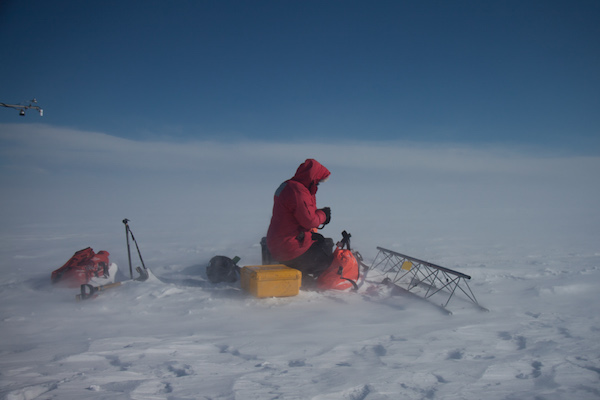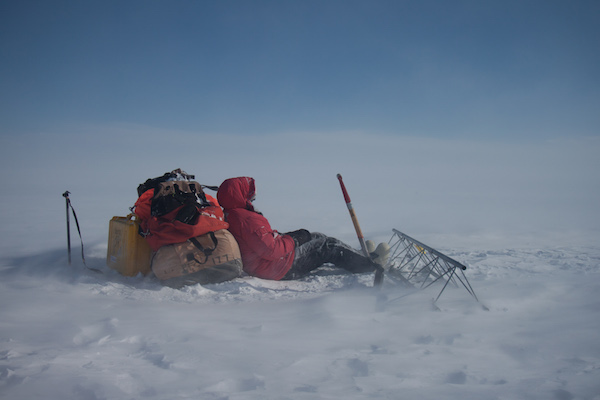Mark and I escaped a close one a couple days ago. On Saturday, 14 November, we flew helo to Linda AWS, a site about 40 miles southeast of McMurdo. We planned to install a new power system, raise the station, and investigate some issues with the pressure sensor. Hardly anything went according to the plan that day.
We arrived at the AWS at about 9:30 am. We unloaded all of our cargo from the helo, then spent the next 20 minutes verifying that we could get communications through to both McMurdo and the helicopter. Each of us bring a VHF radio that we can use to call in to McMurdo (specifically “MacOps” or McMurdo Operations) to let them know we’ve landed, as well as request for any assistance, including letting them know that we want to be picked up. We also use the radio to communicate with the helo pilots who would come pick us up. We have one satellite phone as a backup to the radios. It works just like a regular phone, such that we can call pretty much anyone. We couldn’t get a direct connection to MacOps through the radios, so we had to test going through some repeaters. That didn’t work, so we used the phone to call in. Then we tried the radios again and were finally able to speak with MacOps. I’m glad we took the time to make sure the communications worked properly.
The weather when we landed wasn’t ideal. Temperatures were OK at around 8 F, but winds were at 21 mph and only increased throughout our visit.

Linda AWS when we arrived. You can sort of tell how windy it is by looking at the blowing snow at the surface.
Given the current height of the station, we decided not to raise it with another tower section. We decided to save the power system to install for last and work on the solar panel and the pressure sensor. The solar panel had come loose from its mount, so Mark climbed up and refastened it. The pressure hasn’t been transmitting, so I looked at the sensor to see if I could find any issues with it. I couldn’t, so I left it be, for further investigation.
Once we had finished these tasks, we noticed that the winds had increased, along with the blowing snow. Land features like White Island and Minna Bluff, which were clearly visible when we landed, were getting harder and harder to see. It was at this point (around 11:00 am) that we decided to call MacOps to request to be picked up.
MacOps said a helo wouldn’t be coming to pick us up for another hour or so. In the mean time, we tried to dig out the existing power system. With the wind and blowing snow, that proved to be difficult, so we didn’t fully dig it out.
We built a wind wall with our equipment to block the wind; the power system that we didn’t install came in handy here, as it is a big, bulky box. Eventually we were both sitting there, listening to the winds howl, watching the blowing snow accumulate on our pants and jackets, and waiting for the approaching helo pilot to radio to us, telling us he was close. The horizon was impossible to see, but overhead we could see blue sky. This was encouraging, as it meant the helo pilot could most likely see us and be able to land. If it was an overcast day, the helo may not have been able to land (due to poor surface definition) and we would have had to wait until the weather cleared, perhaps meaning we would need to camp overnight. Our chances of being picked up were also higher because the same pilot that dropped us off was picking us up; he had the exact coordinates of our location and knew what to look for.
After about an hour and 15 minutes of waiting, we finally were contacted by the helo pilot that he was 5 minutes out. What a great feeling that was to hear his voice! When he landed, he kept the blades spinning (a “hot landing”) so we packed up our gear and got out of there as soon as possible.

Linda AWS after our visit, taken from the helicopter. This is looking into the wind, giving a good idea of how the horizon definition decreased dramatically. (The black box at the base on the right is the new power system, which we did not install, but rather just left at the site.)
Here are the observations recorded from Linda AWS during our visit. The time of 203000 UTC corresponds to 9:30 am McMurdo time.
STATION JULDATE TIME T(C) P(MB) SPD(M/S) DIR(DEG) RH(%)
Linda 2015317 203000 -12.6 NaN 9.7 206 58 Linda 2015317 204000 -12.7 NaN 11.1 199 60 Linda 2015317 205000 -13.1 NaN 11.4 209 66 Linda 2015317 210000 -13.4 NaN 10.7 212 67 Linda 2015317 211000 -14.5 NaN 11.0 206 72 Linda 2015317 212000 -15.4 NaN 12.3 201 73 Linda 2015317 221000 -17.0 NaN 11.5 202 74 Linda 2015317 222000 -17.2 NaN 12.9 203 74 Linda 2015317 223000 -17.6 NaN 13.6 196 73 Linda 2015317 224000 -17.8 NaN 14.0 195 74 Linda 2015317 225000 -17.9 NaN 14.3 193 75 Linda 2015317 230000 -17.9 NaN 14.3 190 75 Linda 2015317 231000 -17.8 NaN 13.8 188 76 Linda 2015317 232000 -17.7 NaN 14.9 186 75 Linda 2015317 233000 -17.6 NaN 14.0 185 76
It’s a visit like this that reaffirms my appreciation for the effectiveness of MacOps and Helo Operations. That Saturday may not seem like a huge deal to them (probably because everything on their end went relatively smoothly, overall) but their actions allowed me to sleep in a warm bed that night, and for that, I am very grateful.






